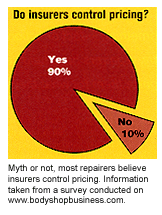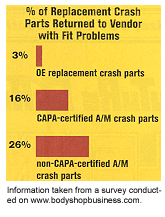There’s a particularly dangerous strain of misinformation – more commonly known as bull – that’s taken up residence in a body shop near you.
When they say information is power, the saying also applies to misinformation. In every conflict in history, the opponents worked hard to learn as much about the other side as possible, while at the same time, directing a campaign of misinformation toward their foe.
Imagine a battle in which every soldier believed his rifle would overheat and be rendered useless if it was fired more than three times in an hour? Well, some of the things we’ve been led to believe are just as damaging.
Let’s take a look at a few of the ideas that have formed the basis for our belief system over the last couple of decades – and at how these beliefs are wreaking havoc on the collision repair industry.
Bull: Insurance Companies Control Prices and Processes
Truth: The only party with any say so in terms of what happens to a vehicle is its owner. Period. Any proposals from a third-party (read: insurer-generated estimates, supplements) are only as relevant as the owner of the car and the repairer deem them to be. No one can force your customer to use parts that are clearly inferior any more than one can compel a customer to use water colors to re-paint his car.
The recurring theme from State Farm Insurance Company that surfaced during the landmark aftermarket parts class-action case was the company’s insistence that “State Farm does not repair cars.” And when insurers choose not to exercise their option to repair per the insurance contract, their influence cannot extend into the repair process. All they can do is pay the bill. The price for repair, regardless if adjusted up or down to suit either party in the repair transaction is (and always will be) established independently, insurance claim notwithstanding. That is, whatever is agreed upon by the customer and his body shop is a transaction apart from a claim. Even if the repairer sees additional damage and calls an insurance rep out for a supplement to the claim, he’s not held to the terms or figures in said supplement. The fact remains that an insurer, regardless of it being a first- or third-party claim, has an obligation to cover the loss. What an insured/claimant does with the money is entirely his business.
Consumer laws and those that specifically address auto repair are the ones body shops must abide by. In most cases, the laws don’t differentiate between body shops and repair shops in general, but typically say a repairer must provide itemized bills with parts detail and, in some cases, identify the part’s origin, such as non-OEM, salvage, reconditioned, etc.

If there is a law in any state that says a third-party payer has any say in the outcome in terms of the repair, I have yet to see it. By the same notion, no state has given authority over prices charged by body shops to insurance companies. It would be a clear case of the tail wagging the dog.
This is not to imply that such tail wagging isn’t exactly the case in the body shop business. To a great extent, this is what happens when shops cede control to insurers and literally tie their own hands in the process.
A recent experience with an Acura dealer’s body shop in Maryland shows me how helpless management has become in this trade. In the course of a repair to a six-day-old TL, the shop saw a clear need for an outer wheelhouse, but was hogtied by an unconvinced Nationwide insurance adjuster – who wanted them to try to magically make the torn sheet metal mend itself.
Stymied by their reluctance, the shop let the car remain in limbo and never once discussed the issue with its owner, who, by the way, was not even insured by Nationwide.
What makes this story so pathetic occurred when the car was reported by the body shop as having been completed and ready to deliver to its customer. When asked what the final bill was, the manager replied, “I don’t know. Nationwide hasn’t told me yet.”
Ina Delong, the noted consumer advocate who left a long career with State Farm after butting heads with her company in her attempts to fairly settle homeowners claims after the Loma Prieta earthquake, put it succinctly. She said, “The only role an insurance company has is writing checks.”
The fact that so few body shop owners grasp this truism is tragic.
Bull: OEMs Produce Perfect Products
Truth: A good friend of mine who’s been a Sikkens rep for as long as the paint’s been in the United States likes to say, “There are no car gods.” And after seeing my late-model Camry throw a rod recently, I have to agree.

If I may play devil’s advocate for a moment, it’s an arguable fact that OEM build quality and materials aren’t always what they could (or should) be. A perfect example is the OEM paint disasters of the late ’80s and early ’90s, in which color coats on selected vehicles blew away like autumn leaves.
The delamination claims and costs to the North American automakers ran into the hundreds of millions, according to industry sources. And in a case in which a body shop applies an aftermarket urethane finish to one of those models, one might say it’s an improvement on OE quality.
Daimler Chrysler’s body shop point man Daryl Porter said in a recent presentation that the urethane coatings being applied in the aftermarket can often exceed the OEM finishes.
The point here is that factory ain’t always the best, and in some cases, the products are downright disgraceful.
Take a look at the early ’90s Ford Explorers on the roads in the rust belt. A recent visit by me to the Chicago area underscores the fact that the fabled SUVs are rotting like 1957 models sold by the same Dearborn carmaker. What for many cars is an indication of non-OE panels and paint gone bad as a result of a poor collision repair job is reappearing in the factory assemblies like some awful d













